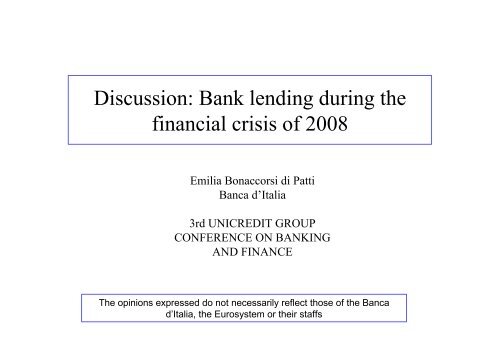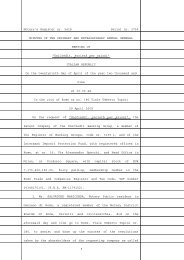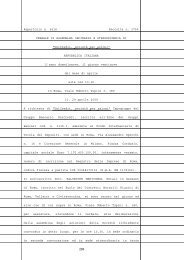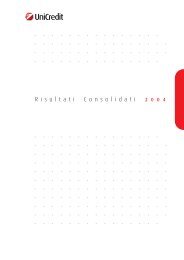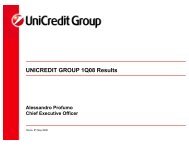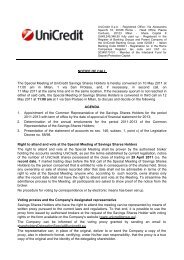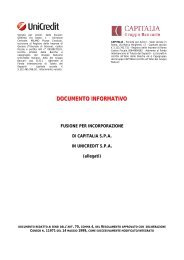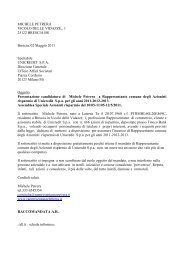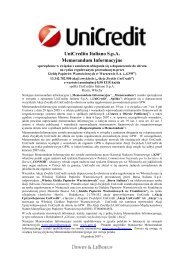Session 2 â Emilia Bonaccorsi di Patti presentation - UniCredit Group
Session 2 â Emilia Bonaccorsi di Patti presentation - UniCredit Group
Session 2 â Emilia Bonaccorsi di Patti presentation - UniCredit Group
You also want an ePaper? Increase the reach of your titles
YUMPU automatically turns print PDFs into web optimized ePapers that Google loves.
Discussion: Bank len<strong>di</strong>ng during the<br />
financial crisis of 2008<br />
<strong>Emilia</strong> <strong>Bonaccorsi</strong> <strong>di</strong> <strong>Patti</strong><br />
Banca d’Italia<br />
3rd UNICREDIT GROUP<br />
CONFERENCE ON BANKING<br />
AND FINANCE<br />
The opinions expressed do not necessarily reflect those of the Banca<br />
d’Italia, the Eurosystem or their staffs
What is the impact of the crisis on cre<strong>di</strong>t<br />
availability?<br />
• Debate on cre<strong>di</strong>t crunch in the US [Chari et al. Vs.<br />
others]: some stu<strong>di</strong>es are starting to show that there<br />
are negative cre<strong>di</strong>t supply effects from the crisis for<br />
Spain, Germany, Italy…[older research on <strong>di</strong>stress in<br />
Japan, US, Korea, etc.]<br />
• Identification is the key issue: <strong>di</strong>fficult to solve,<br />
especially with US data (not very much information<br />
from micro data)<br />
• Need to find some exogenous possibly heterogeneous<br />
supply shock to banks not correlated with demand<br />
shock link this to cre<strong>di</strong>t
This Paper in a Nutshell<br />
• 38 banks, inclu<strong>di</strong>ng investment banks and foreign<br />
banks<br />
• Look at syn<strong>di</strong>cated loan issuances after Lehman<br />
compared to pre-crisis (mid-2007) or crisis I (August<br />
2007-July 2008)<br />
IDENTIFICATION STRATEGY<br />
1. Banks are <strong>di</strong>fferentiated by the importance of<br />
deposits: more deposits, more stable fun<strong>di</strong>ng<br />
2. Banks that cosyn<strong>di</strong>cated cre<strong>di</strong>t lines with Lehman<br />
more exposed to liqui<strong>di</strong>ty shock
The Bottom Line<br />
• There are supply effects on new syn<strong>di</strong>cated loans due<br />
to liqui<strong>di</strong>ty run on banks<br />
• Robustness analysis supports the view that indeed it<br />
is a supply effect rather than something coming from<br />
demand drop only
Comments<br />
• Nice paper, generally convincing evidence although not<br />
conclusive<br />
• The paper is stronger when it looks at the impact of the<br />
Lehman shock on loan issuance by banks, it is less convincing<br />
when it looks at the share of deposit fun<strong>di</strong>ng<br />
• Not sure that the relationship found between deposits and new<br />
syn<strong>di</strong>cated loans is a explained by a liqui<strong>di</strong>ty shock:<br />
The determinant could be another, more persistent explanation based<br />
on bank portfolio allocation: banks are recomposing their portfolios<br />
towards more liquid assets, are deleveraging from riskier assets<br />
Banks with more deposits might be those that had less leverage or less<br />
risk<br />
• Different policy conclusion<br />
• Interpretation of current situation: Access to liqui<strong>di</strong>ty for<br />
banks does not appear to be the determinant of current cre<strong>di</strong>t<br />
dynamics
Senior Loan Officer Survey (FRB) – Me<strong>di</strong>um and Large Banks<br />
100<br />
80<br />
60<br />
40<br />
20<br />
I-00<br />
II-00<br />
III-00<br />
IV-00<br />
I-01<br />
II-01<br />
III-01<br />
IV-01<br />
I-02<br />
II-02<br />
III-02<br />
IV-02<br />
I-03<br />
II-03<br />
III-03<br />
IV-03<br />
I-04<br />
II-04<br />
III-04<br />
IV-04<br />
I-05<br />
II-05<br />
III-05<br />
IV-05<br />
I-06<br />
II-06<br />
III-06<br />
IV-06<br />
I-07<br />
II-07<br />
III-07<br />
IV-07<br />
I-08<br />
II-08<br />
III-08<br />
IV-08<br />
I-09<br />
II-09<br />
III-09<br />
IV-09<br />
0<br />
-20<br />
-40<br />
-60<br />
-80<br />
Net percentage of banks experiencing a demand increase<br />
Net percentage of banks in<strong>di</strong>cating a tightening of cre<strong>di</strong>t standards
OCTOBER 2007<br />
“Almost all domestic banks and U.S. branches and agencies of foreign banks that<br />
reported having tightened their len<strong>di</strong>ng standards and terms on C&I loans pointed to a<br />
less favorable or more uncertain economic outlook as a reason for having done so.<br />
Large majorities of both domestic and foreign respondents also cited decreased<br />
liqui<strong>di</strong>ty in the secondary market and reduced tolerance for risk as reasons for a move<br />
toward more-stringent len<strong>di</strong>ng policies. By contrast, relatively few respondents<br />
in<strong>di</strong>cated that concerns about their banks’ capital or liqui<strong>di</strong>ty positions had<br />
contributed to the tightening of len<strong>di</strong>ng standards and terms.”<br />
JULY 2008<br />
“Very large majorities of domestic and foreign respondents pointed to a less favorable<br />
or more uncertain economic outlook, their bank’s reduced tolerance for risk, and the<br />
worsening of industry-specific problems as reasons for tightening their len<strong>di</strong>ng<br />
standards and terms on C&I loans over the past three months. Roughly 65 percent of<br />
foreign respondents —up from about 45 percent in the April survey—also noted that<br />
concerns about their bank’s current or expected capital position had contributed to the<br />
more-stringent len<strong>di</strong>ng policies over the past three months. In contrast, only about 25<br />
percent of domestic respondents—down from about 35 percent in the April survey—<br />
reported having tightened their len<strong>di</strong>ng standards because of concerns about their<br />
bank’s current or expected capital position.”
OCTOBER 2008<br />
“Almost all domestic and foreign respondents pointed to a less favorable or more<br />
uncertain economic outlook as a reason for tightening their len<strong>di</strong>ng standards and<br />
terms on C&I loans over the past three months. Large majorities of respondents<br />
in<strong>di</strong>cated that their bank’s reduced tolerance for risk and a worsening of industryspecific<br />
problems were factors in their decision. Roughly 75 percent of foreign<br />
respondents and about 40 percent of domestic respondents noted that a deterioration in<br />
their bank’s current or expected capital position had contributed to the move toward<br />
more stringent len<strong>di</strong>ng policies over the past three months..”<br />
JANUARY 2009<br />
“All domestic and foreign respondents pointed to a less favorable or more uncertain<br />
economic outlook as a reason for tightening their len<strong>di</strong>ng standards and terms on C&I<br />
loans over the past three months. Most respondents in<strong>di</strong>cated that a worsening of<br />
industry-specific problems and their bank's reduced tolerance for risk were also<br />
important factors in their decision to tighten C&I len<strong>di</strong>ng policies. In contrast, only<br />
about 25 percent of the domestic respondents that had tightened standards or terms<br />
noted that a deterioration in their bank's current or expected capital position had<br />
contributed to the change, in comparison with approximately 40 percent in the October<br />
survey. High net percentages of foreign respondents gave as reasons for tightening<br />
standards and terms on C&I loans decreased liqui<strong>di</strong>ty in the secondary market for C&I<br />
loans and an increase in defaults by borrowers in public debt markets.”
More Comments<br />
• Why not look at Crisis I versus Pre-crisis? Liqui<strong>di</strong>ty shocks<br />
also in Crisis I [cannot use the Lehman shock but the deposit<br />
story should hold], comparing result could help interpretation<br />
• What about capital? In Crisis II more likely to have capital<br />
structure weakness: how can we <strong>di</strong>stinguish between liqui<strong>di</strong>ty<br />
and capital constrained banks?<br />
– The authors say that the decline in cre<strong>di</strong>t lines with longer maturities<br />
was larger than other loans because they require banks to hold more<br />
regulatory capital<br />
• Foreign banks are important in the sample: how many there<br />
are? They are probably funded by their parent: in other<br />
countries evidence of significant internal capital markets, can<br />
this affect results? Unfortunately the sample is very small
Open Issues<br />
• Would like to see what has happened after November<br />
2008 the collapse of certain markets is changing<br />
again the interme<strong>di</strong>ation model? The aggregate data<br />
show that large US banks are increasing their hol<strong>di</strong>ng<br />
of liquid assets<br />
• The syn<strong>di</strong>cated loan market is a very special segment<br />
of banks’ activity and a form of financing that only<br />
very large firms use<br />
– Firms that used syn<strong>di</strong>cated loans in the past might have<br />
shifted to other forms of financing<br />
– Could this reflect substitutions between syn<strong>di</strong>cated loans<br />
and more liquid forms of financing? What are these<br />
borrowers doing?
Conclusion<br />
• I enjoyed rea<strong>di</strong>ng the paper<br />
• Consistent with some evidence from other countries<br />
• The Lehman shock has been used by other stu<strong>di</strong>es<br />
(Germany, Italy) we should think about temporary<br />
versus more persistent shocks (drying up of<br />
secondary markets, securitization, ecc.)<br />
Need more research on the impact of bank fun<strong>di</strong>ng<br />
on cre<strong>di</strong>t con<strong>di</strong>tions to large and small borrowers
Thank you


